Comprehensive Analysis of HRM Strategies and Practices at ALDI
VerifiedAdded on 2020/06/04
|15
|4434
|69
Report
AI Summary
This report provides a comprehensive analysis of Human Resource Management (HRM) practices within ALDI, a leading grocery retailer. It begins with an introduction to HRM, explaining its purposes and functions in workforce planning and resourcing, specifically within the context of ALDI's operations. The report then assesses the role of HRM in providing talent and skills to meet business objectives, followed by an evaluation of different recruitment and selection approaches, comparing their strengths and weaknesses, both internally and externally. The benefits of HRM practices on both employers and employees are detailed, alongside an explanation of various HRM methods, supported by specific examples. Furthermore, the report critically evaluates HRM practices within an organizational context, assessing their effectiveness in raising organizational profit and productivity. The importance of employee relations in influencing HRM decision-making is analyzed, including the impact of employment legislation. The report concludes by illustrating the application of HRM practices in a work-related context, offering a rationale for specific practices.
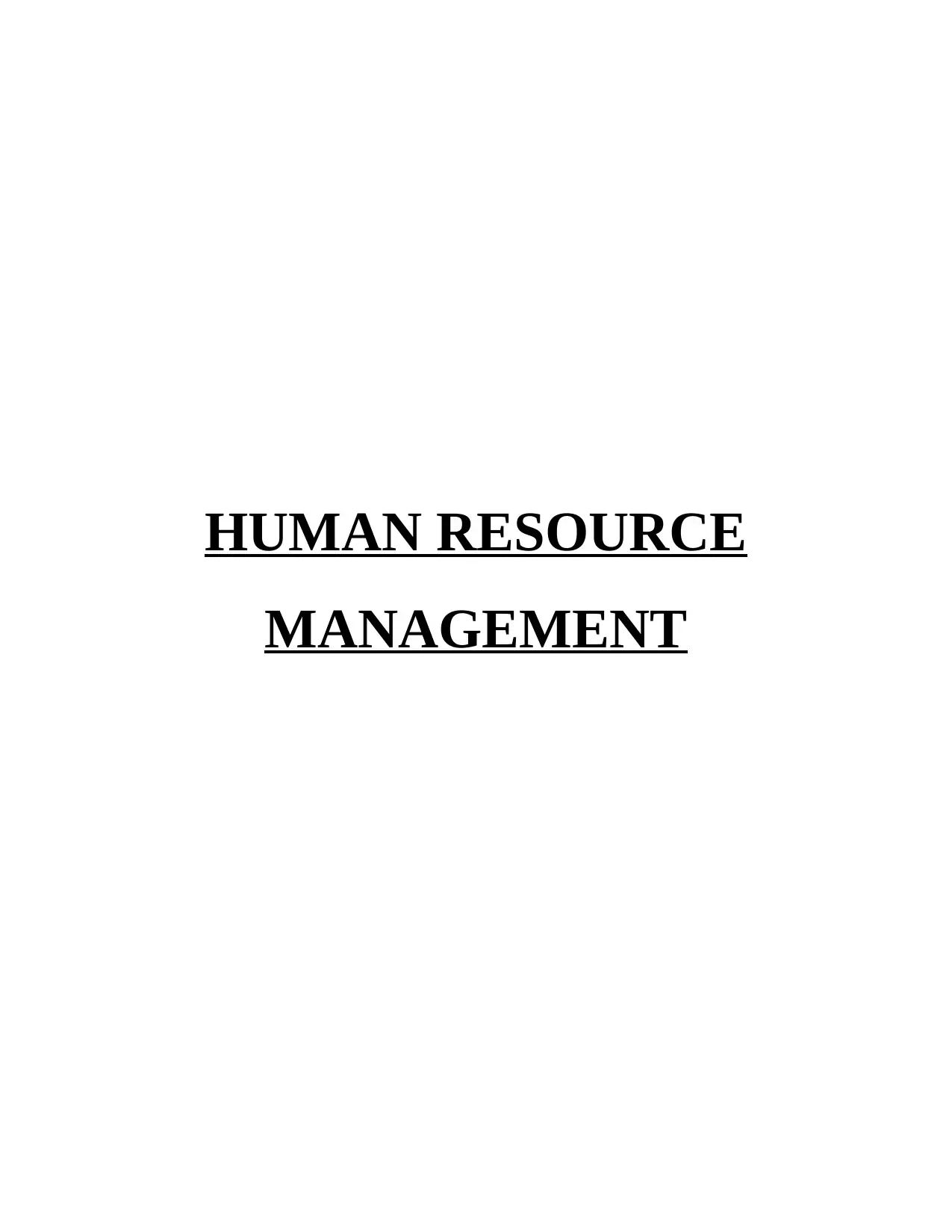
HUMAN RESOURCE
MANAGEMENT
MANAGEMENT
Paraphrase This Document
Need a fresh take? Get an instant paraphrase of this document with our AI Paraphraser
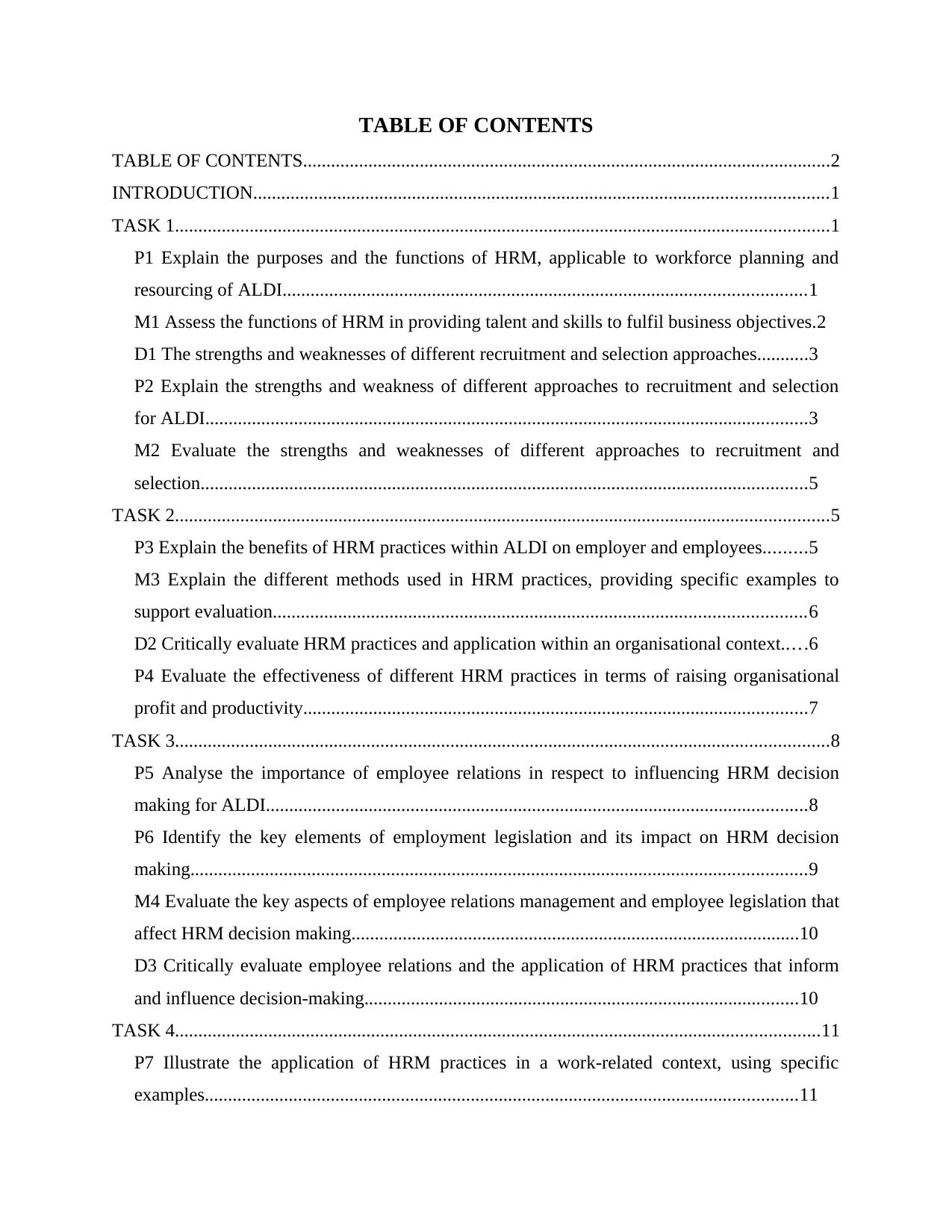
TABLE OF CONTENTS
TABLE OF CONTENTS.................................................................................................................2
INTRODUCTION...........................................................................................................................1
TASK 1............................................................................................................................................1
P1 Explain the purposes and the functions of HRM, applicable to workforce planning and
resourcing of ALDI................................................................................................................1
M1 Assess the functions of HRM in providing talent and skills to fulfil business objectives.2
D1 The strengths and weaknesses of different recruitment and selection approaches...........3
P2 Explain the strengths and weakness of different approaches to recruitment and selection
for ALDI.................................................................................................................................3
M2 Evaluate the strengths and weaknesses of different approaches to recruitment and
selection..................................................................................................................................5
TASK 2............................................................................................................................................5
P3 Explain the benefits of HRM practices within ALDI on employer and employees.........5
M3 Explain the different methods used in HRM practices, providing specific examples to
support evaluation..................................................................................................................6
D2 Critically evaluate HRM practices and application within an organisational context.....6
P4 Evaluate the effectiveness of different HRM practices in terms of raising organisational
profit and productivity............................................................................................................7
TASK 3............................................................................................................................................8
P5 Analyse the importance of employee relations in respect to influencing HRM decision
making for ALDI....................................................................................................................8
P6 Identify the key elements of employment legislation and its impact on HRM decision
making....................................................................................................................................9
M4 Evaluate the key aspects of employee relations management and employee legislation that
affect HRM decision making................................................................................................10
D3 Critically evaluate employee relations and the application of HRM practices that inform
and influence decision-making.............................................................................................10
TASK 4..........................................................................................................................................11
P7 Illustrate the application of HRM practices in a work-related context, using specific
examples...............................................................................................................................11
TABLE OF CONTENTS.................................................................................................................2
INTRODUCTION...........................................................................................................................1
TASK 1............................................................................................................................................1
P1 Explain the purposes and the functions of HRM, applicable to workforce planning and
resourcing of ALDI................................................................................................................1
M1 Assess the functions of HRM in providing talent and skills to fulfil business objectives.2
D1 The strengths and weaknesses of different recruitment and selection approaches...........3
P2 Explain the strengths and weakness of different approaches to recruitment and selection
for ALDI.................................................................................................................................3
M2 Evaluate the strengths and weaknesses of different approaches to recruitment and
selection..................................................................................................................................5
TASK 2............................................................................................................................................5
P3 Explain the benefits of HRM practices within ALDI on employer and employees.........5
M3 Explain the different methods used in HRM practices, providing specific examples to
support evaluation..................................................................................................................6
D2 Critically evaluate HRM practices and application within an organisational context.....6
P4 Evaluate the effectiveness of different HRM practices in terms of raising organisational
profit and productivity............................................................................................................7
TASK 3............................................................................................................................................8
P5 Analyse the importance of employee relations in respect to influencing HRM decision
making for ALDI....................................................................................................................8
P6 Identify the key elements of employment legislation and its impact on HRM decision
making....................................................................................................................................9
M4 Evaluate the key aspects of employee relations management and employee legislation that
affect HRM decision making................................................................................................10
D3 Critically evaluate employee relations and the application of HRM practices that inform
and influence decision-making.............................................................................................10
TASK 4..........................................................................................................................................11
P7 Illustrate the application of HRM practices in a work-related context, using specific
examples...............................................................................................................................11
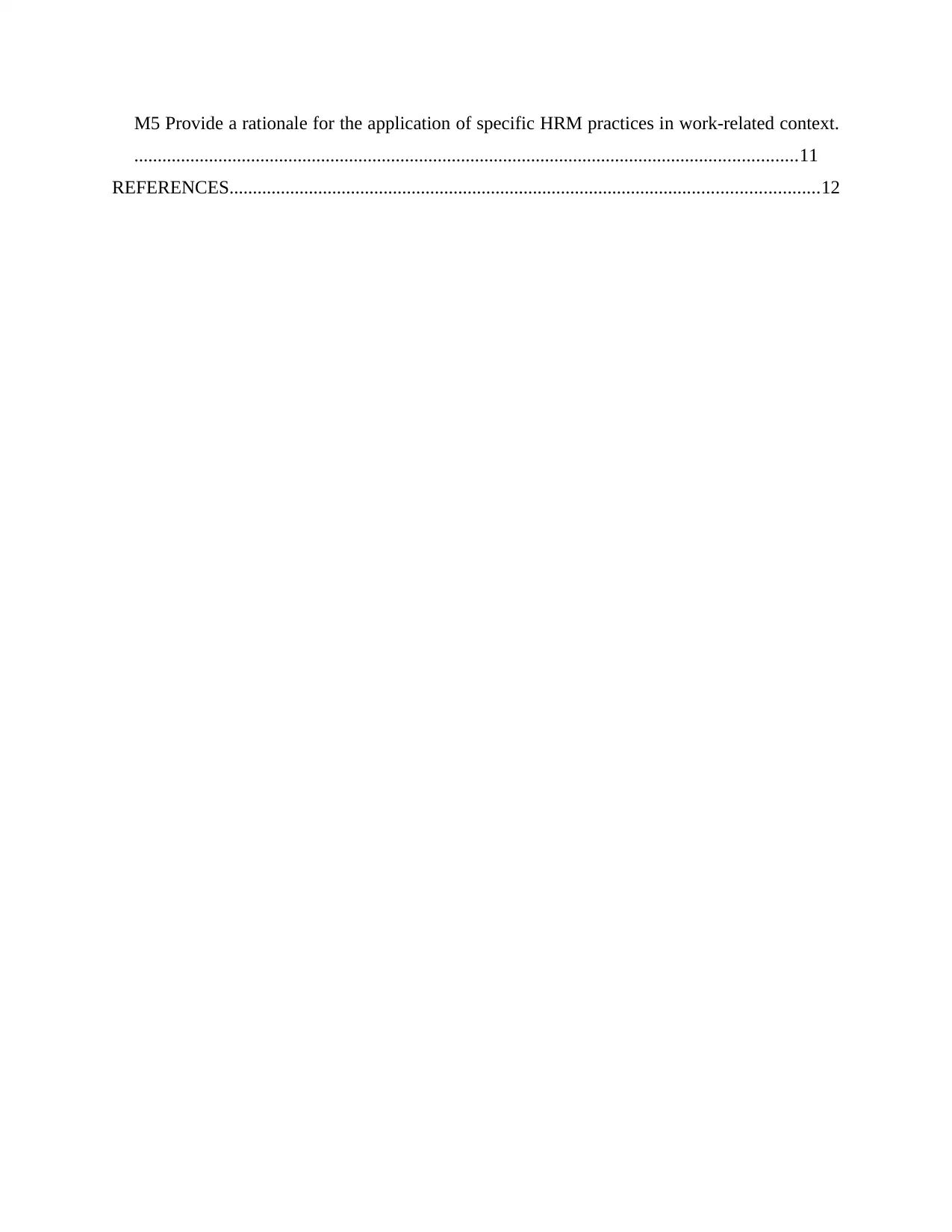
M5 Provide a rationale for the application of specific HRM practices in work-related context.
..............................................................................................................................................11
REFERENCES..............................................................................................................................12
..............................................................................................................................................11
REFERENCES..............................................................................................................................12
⊘ This is a preview!⊘
Do you want full access?
Subscribe today to unlock all pages.

Trusted by 1+ million students worldwide
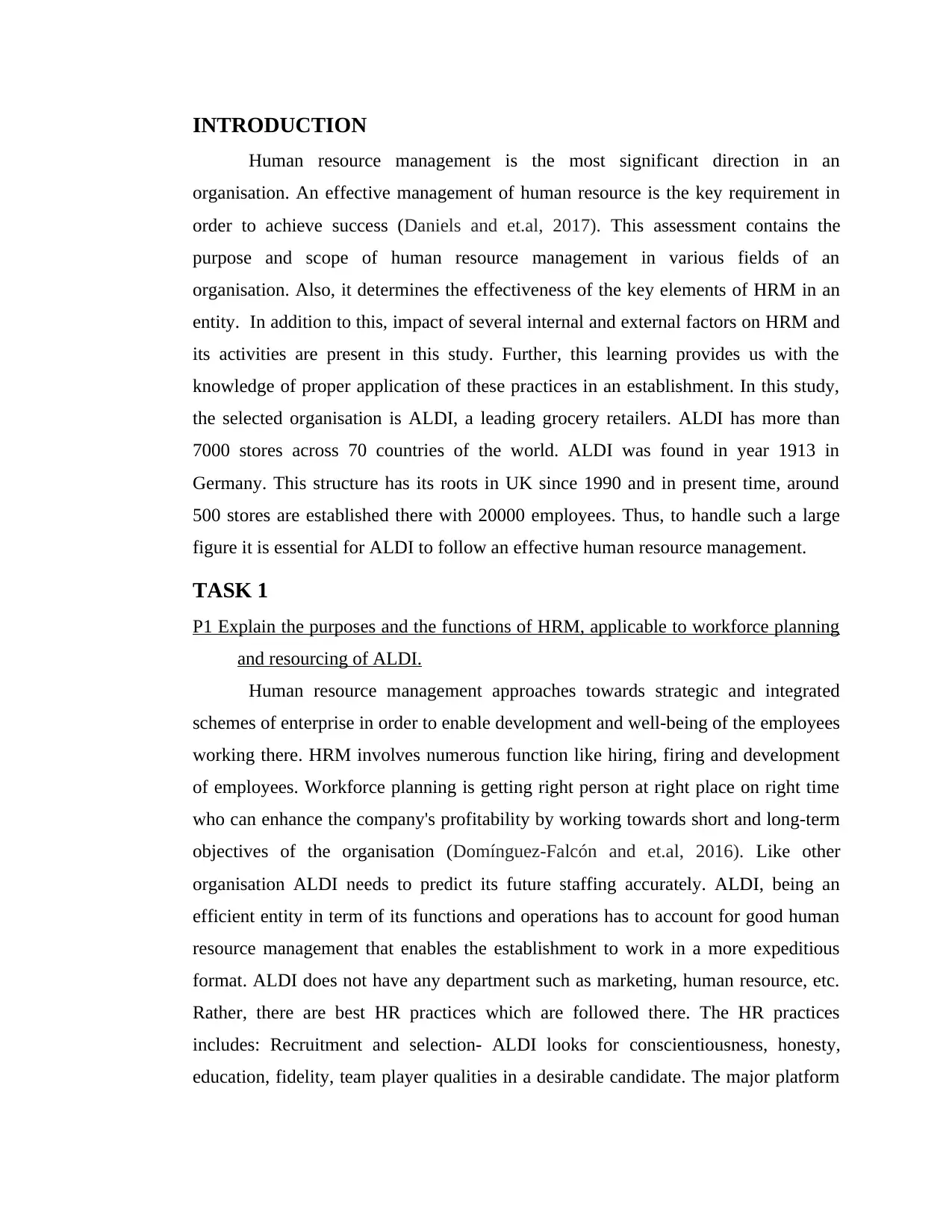
INTRODUCTION
Human resource management is the most significant direction in an
organisation. An effective management of human resource is the key requirement in
order to achieve success (Daniels and et.al, 2017). This assessment contains the
purpose and scope of human resource management in various fields of an
organisation. Also, it determines the effectiveness of the key elements of HRM in an
entity. In addition to this, impact of several internal and external factors on HRM and
its activities are present in this study. Further, this learning provides us with the
knowledge of proper application of these practices in an establishment. In this study,
the selected organisation is ALDI, a leading grocery retailers. ALDI has more than
7000 stores across 70 countries of the world. ALDI was found in year 1913 in
Germany. This structure has its roots in UK since 1990 and in present time, around
500 stores are established there with 20000 employees. Thus, to handle such a large
figure it is essential for ALDI to follow an effective human resource management.
TASK 1
P1 Explain the purposes and the functions of HRM, applicable to workforce planning
and resourcing of ALDI.
Human resource management approaches towards strategic and integrated
schemes of enterprise in order to enable development and well-being of the employees
working there. HRM involves numerous function like hiring, firing and development
of employees. Workforce planning is getting right person at right place on right time
who can enhance the company's profitability by working towards short and long-term
objectives of the organisation (Domínguez-Falcón and et.al, 2016). Like other
organisation ALDI needs to predict its future staffing accurately. ALDI, being an
efficient entity in term of its functions and operations has to account for good human
resource management that enables the establishment to work in a more expeditious
format. ALDI does not have any department such as marketing, human resource, etc.
Rather, there are best HR practices which are followed there. The HR practices
includes: Recruitment and selection- ALDI looks for conscientiousness, honesty,
education, fidelity, team player qualities in a desirable candidate. The major platform
Human resource management is the most significant direction in an
organisation. An effective management of human resource is the key requirement in
order to achieve success (Daniels and et.al, 2017). This assessment contains the
purpose and scope of human resource management in various fields of an
organisation. Also, it determines the effectiveness of the key elements of HRM in an
entity. In addition to this, impact of several internal and external factors on HRM and
its activities are present in this study. Further, this learning provides us with the
knowledge of proper application of these practices in an establishment. In this study,
the selected organisation is ALDI, a leading grocery retailers. ALDI has more than
7000 stores across 70 countries of the world. ALDI was found in year 1913 in
Germany. This structure has its roots in UK since 1990 and in present time, around
500 stores are established there with 20000 employees. Thus, to handle such a large
figure it is essential for ALDI to follow an effective human resource management.
TASK 1
P1 Explain the purposes and the functions of HRM, applicable to workforce planning
and resourcing of ALDI.
Human resource management approaches towards strategic and integrated
schemes of enterprise in order to enable development and well-being of the employees
working there. HRM involves numerous function like hiring, firing and development
of employees. Workforce planning is getting right person at right place on right time
who can enhance the company's profitability by working towards short and long-term
objectives of the organisation (Domínguez-Falcón and et.al, 2016). Like other
organisation ALDI needs to predict its future staffing accurately. ALDI, being an
efficient entity in term of its functions and operations has to account for good human
resource management that enables the establishment to work in a more expeditious
format. ALDI does not have any department such as marketing, human resource, etc.
Rather, there are best HR practices which are followed there. The HR practices
includes: Recruitment and selection- ALDI looks for conscientiousness, honesty,
education, fidelity, team player qualities in a desirable candidate. The major platform
Paraphrase This Document
Need a fresh take? Get an instant paraphrase of this document with our AI Paraphraser
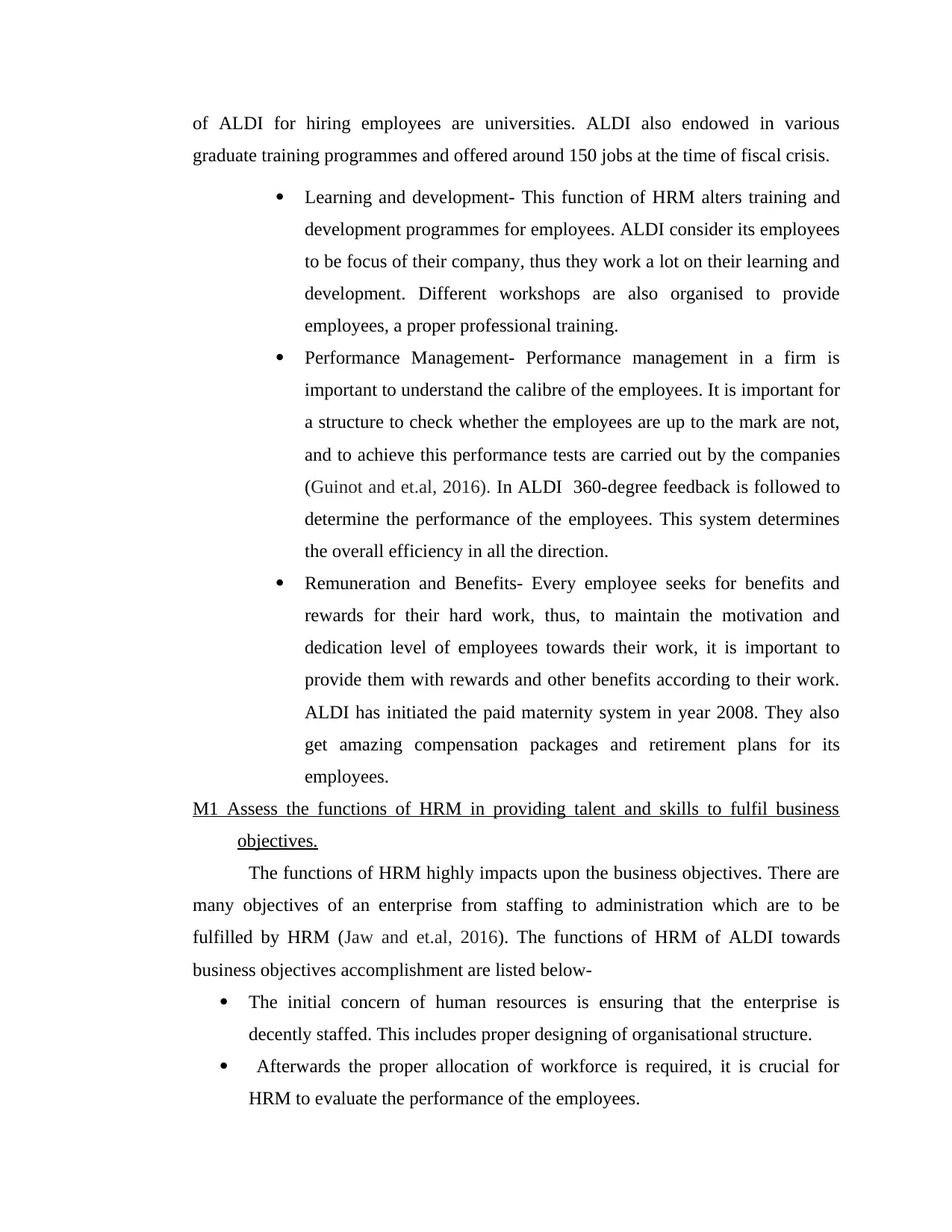
of ALDI for hiring employees are universities. ALDI also endowed in various
graduate training programmes and offered around 150 jobs at the time of fiscal crisis.
Learning and development- This function of HRM alters training and
development programmes for employees. ALDI consider its employees
to be focus of their company, thus they work a lot on their learning and
development. Different workshops are also organised to provide
employees, a proper professional training.
Performance Management- Performance management in a firm is
important to understand the calibre of the employees. It is important for
a structure to check whether the employees are up to the mark are not,
and to achieve this performance tests are carried out by the companies
(Guinot and et.al, 2016). In ALDI 360-degree feedback is followed to
determine the performance of the employees. This system determines
the overall efficiency in all the direction.
Remuneration and Benefits- Every employee seeks for benefits and
rewards for their hard work, thus, to maintain the motivation and
dedication level of employees towards their work, it is important to
provide them with rewards and other benefits according to their work.
ALDI has initiated the paid maternity system in year 2008. They also
get amazing compensation packages and retirement plans for its
employees.
M1 Assess the functions of HRM in providing talent and skills to fulfil business
objectives.
The functions of HRM highly impacts upon the business objectives. There are
many objectives of an enterprise from staffing to administration which are to be
fulfilled by HRM (Jaw and et.al, 2016). The functions of HRM of ALDI towards
business objectives accomplishment are listed below-
The initial concern of human resources is ensuring that the enterprise is
decently staffed. This includes proper designing of organisational structure.
Afterwards the proper allocation of workforce is required, it is crucial for
HRM to evaluate the performance of the employees.
graduate training programmes and offered around 150 jobs at the time of fiscal crisis.
Learning and development- This function of HRM alters training and
development programmes for employees. ALDI consider its employees
to be focus of their company, thus they work a lot on their learning and
development. Different workshops are also organised to provide
employees, a proper professional training.
Performance Management- Performance management in a firm is
important to understand the calibre of the employees. It is important for
a structure to check whether the employees are up to the mark are not,
and to achieve this performance tests are carried out by the companies
(Guinot and et.al, 2016). In ALDI 360-degree feedback is followed to
determine the performance of the employees. This system determines
the overall efficiency in all the direction.
Remuneration and Benefits- Every employee seeks for benefits and
rewards for their hard work, thus, to maintain the motivation and
dedication level of employees towards their work, it is important to
provide them with rewards and other benefits according to their work.
ALDI has initiated the paid maternity system in year 2008. They also
get amazing compensation packages and retirement plans for its
employees.
M1 Assess the functions of HRM in providing talent and skills to fulfil business
objectives.
The functions of HRM highly impacts upon the business objectives. There are
many objectives of an enterprise from staffing to administration which are to be
fulfilled by HRM (Jaw and et.al, 2016). The functions of HRM of ALDI towards
business objectives accomplishment are listed below-
The initial concern of human resources is ensuring that the enterprise is
decently staffed. This includes proper designing of organisational structure.
Afterwards the proper allocation of workforce is required, it is crucial for
HRM to evaluate the performance of the employees.
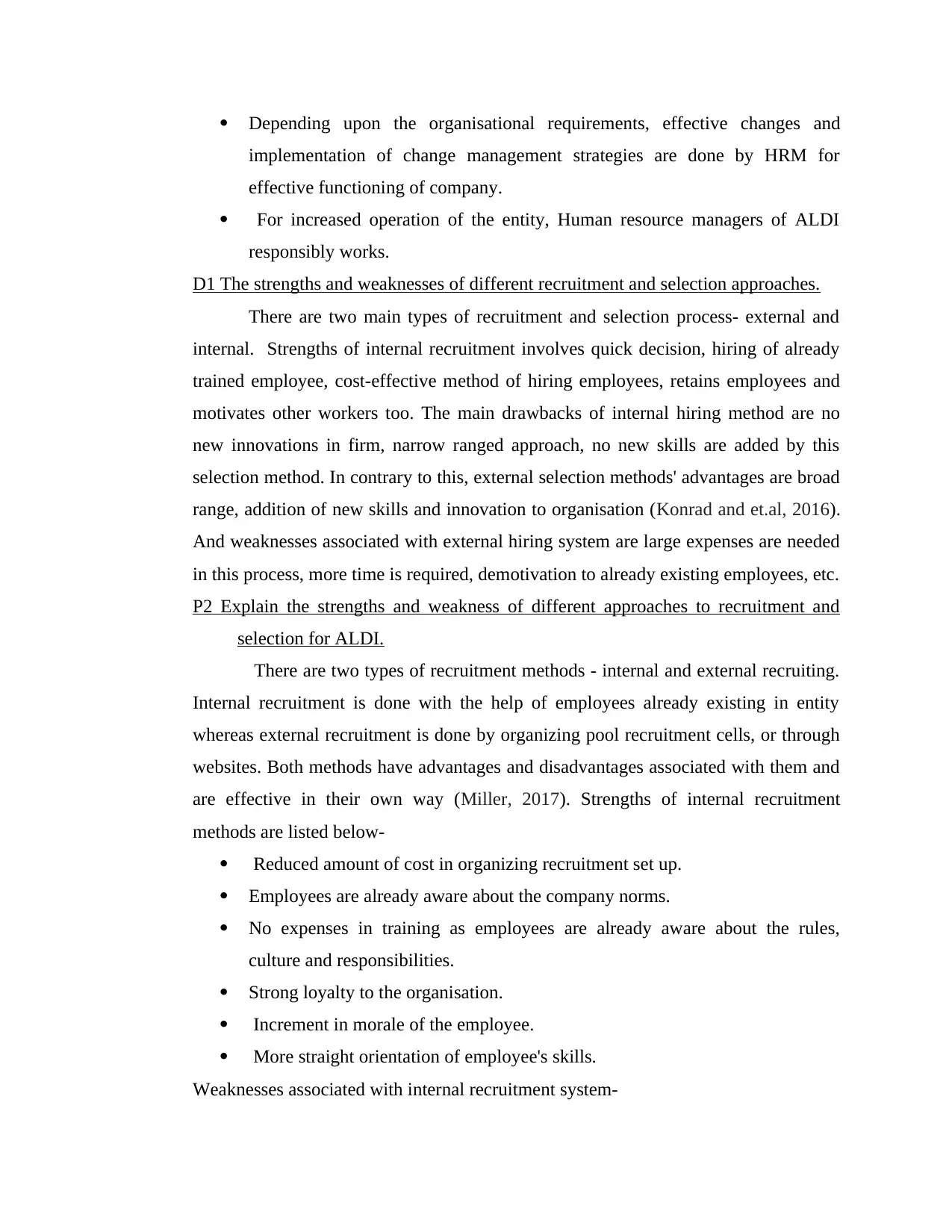
Depending upon the organisational requirements, effective changes and
implementation of change management strategies are done by HRM for
effective functioning of company.
For increased operation of the entity, Human resource managers of ALDI
responsibly works.
D1 The strengths and weaknesses of different recruitment and selection approaches.
There are two main types of recruitment and selection process- external and
internal. Strengths of internal recruitment involves quick decision, hiring of already
trained employee, cost-effective method of hiring employees, retains employees and
motivates other workers too. The main drawbacks of internal hiring method are no
new innovations in firm, narrow ranged approach, no new skills are added by this
selection method. In contrary to this, external selection methods' advantages are broad
range, addition of new skills and innovation to organisation (Konrad and et.al, 2016).
And weaknesses associated with external hiring system are large expenses are needed
in this process, more time is required, demotivation to already existing employees, etc.
P2 Explain the strengths and weakness of different approaches to recruitment and
selection for ALDI.
There are two types of recruitment methods - internal and external recruiting.
Internal recruitment is done with the help of employees already existing in entity
whereas external recruitment is done by organizing pool recruitment cells, or through
websites. Both methods have advantages and disadvantages associated with them and
are effective in their own way (Miller, 2017). Strengths of internal recruitment
methods are listed below-
Reduced amount of cost in organizing recruitment set up.
Employees are already aware about the company norms.
No expenses in training as employees are already aware about the rules,
culture and responsibilities.
Strong loyalty to the organisation.
Increment in morale of the employee.
More straight orientation of employee's skills.
Weaknesses associated with internal recruitment system-
implementation of change management strategies are done by HRM for
effective functioning of company.
For increased operation of the entity, Human resource managers of ALDI
responsibly works.
D1 The strengths and weaknesses of different recruitment and selection approaches.
There are two main types of recruitment and selection process- external and
internal. Strengths of internal recruitment involves quick decision, hiring of already
trained employee, cost-effective method of hiring employees, retains employees and
motivates other workers too. The main drawbacks of internal hiring method are no
new innovations in firm, narrow ranged approach, no new skills are added by this
selection method. In contrary to this, external selection methods' advantages are broad
range, addition of new skills and innovation to organisation (Konrad and et.al, 2016).
And weaknesses associated with external hiring system are large expenses are needed
in this process, more time is required, demotivation to already existing employees, etc.
P2 Explain the strengths and weakness of different approaches to recruitment and
selection for ALDI.
There are two types of recruitment methods - internal and external recruiting.
Internal recruitment is done with the help of employees already existing in entity
whereas external recruitment is done by organizing pool recruitment cells, or through
websites. Both methods have advantages and disadvantages associated with them and
are effective in their own way (Miller, 2017). Strengths of internal recruitment
methods are listed below-
Reduced amount of cost in organizing recruitment set up.
Employees are already aware about the company norms.
No expenses in training as employees are already aware about the rules,
culture and responsibilities.
Strong loyalty to the organisation.
Increment in morale of the employee.
More straight orientation of employee's skills.
Weaknesses associated with internal recruitment system-
⊘ This is a preview!⊘
Do you want full access?
Subscribe today to unlock all pages.

Trusted by 1+ million students worldwide
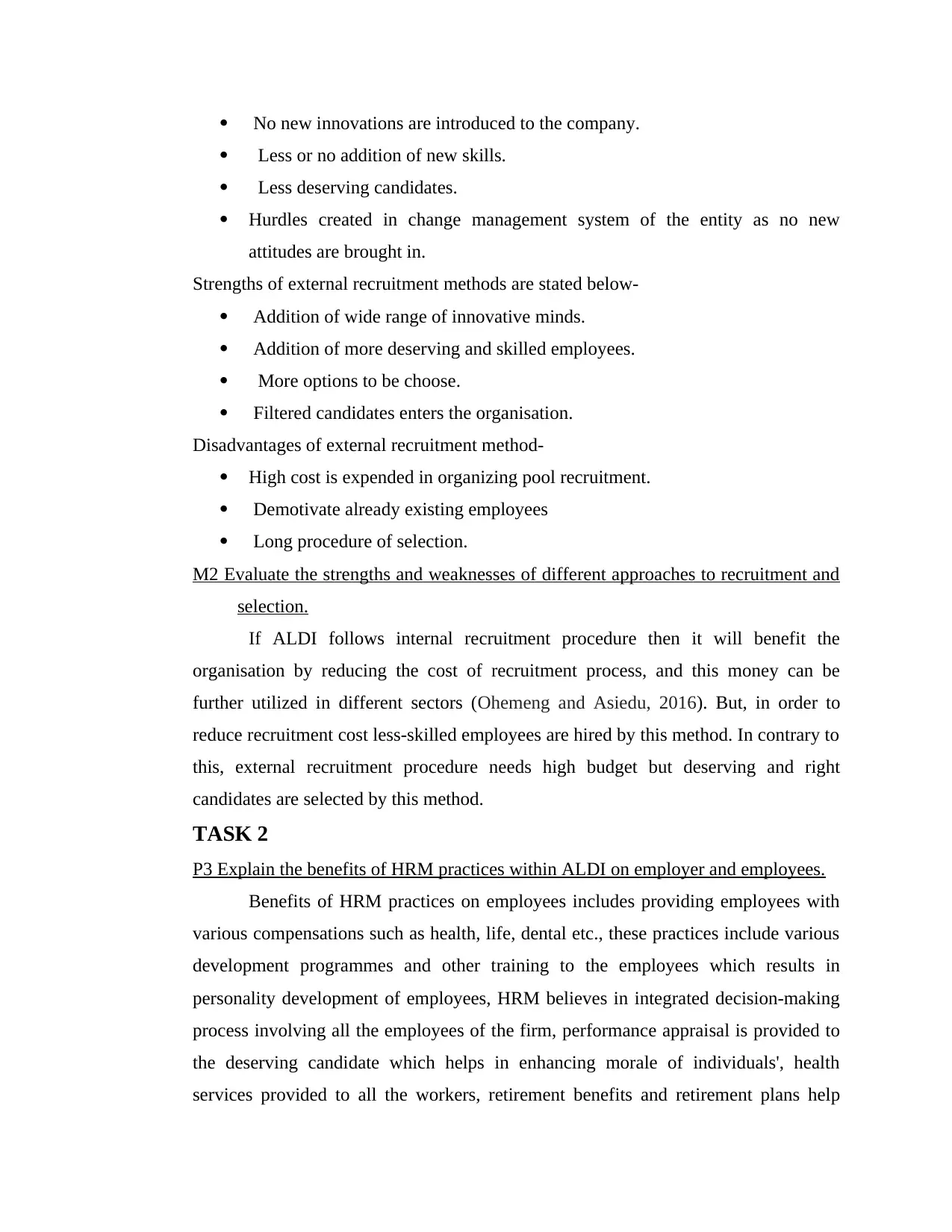
No new innovations are introduced to the company.
Less or no addition of new skills.
Less deserving candidates.
Hurdles created in change management system of the entity as no new
attitudes are brought in.
Strengths of external recruitment methods are stated below-
Addition of wide range of innovative minds.
Addition of more deserving and skilled employees.
More options to be choose.
Filtered candidates enters the organisation.
Disadvantages of external recruitment method-
High cost is expended in organizing pool recruitment.
Demotivate already existing employees
Long procedure of selection.
M2 Evaluate the strengths and weaknesses of different approaches to recruitment and
selection.
If ALDI follows internal recruitment procedure then it will benefit the
organisation by reducing the cost of recruitment process, and this money can be
further utilized in different sectors (Ohemeng and Asiedu, 2016). But, in order to
reduce recruitment cost less-skilled employees are hired by this method. In contrary to
this, external recruitment procedure needs high budget but deserving and right
candidates are selected by this method.
TASK 2
P3 Explain the benefits of HRM practices within ALDI on employer and employees.
Benefits of HRM practices on employees includes providing employees with
various compensations such as health, life, dental etc., these practices include various
development programmes and other training to the employees which results in
personality development of employees, HRM believes in integrated decision-making
process involving all the employees of the firm, performance appraisal is provided to
the deserving candidate which helps in enhancing morale of individuals', health
services provided to all the workers, retirement benefits and retirement plans help
Less or no addition of new skills.
Less deserving candidates.
Hurdles created in change management system of the entity as no new
attitudes are brought in.
Strengths of external recruitment methods are stated below-
Addition of wide range of innovative minds.
Addition of more deserving and skilled employees.
More options to be choose.
Filtered candidates enters the organisation.
Disadvantages of external recruitment method-
High cost is expended in organizing pool recruitment.
Demotivate already existing employees
Long procedure of selection.
M2 Evaluate the strengths and weaknesses of different approaches to recruitment and
selection.
If ALDI follows internal recruitment procedure then it will benefit the
organisation by reducing the cost of recruitment process, and this money can be
further utilized in different sectors (Ohemeng and Asiedu, 2016). But, in order to
reduce recruitment cost less-skilled employees are hired by this method. In contrary to
this, external recruitment procedure needs high budget but deserving and right
candidates are selected by this method.
TASK 2
P3 Explain the benefits of HRM practices within ALDI on employer and employees.
Benefits of HRM practices on employees includes providing employees with
various compensations such as health, life, dental etc., these practices include various
development programmes and other training to the employees which results in
personality development of employees, HRM believes in integrated decision-making
process involving all the employees of the firm, performance appraisal is provided to
the deserving candidate which helps in enhancing morale of individuals', health
services provided to all the workers, retirement benefits and retirement plans help
Paraphrase This Document
Need a fresh take? Get an instant paraphrase of this document with our AI Paraphraser
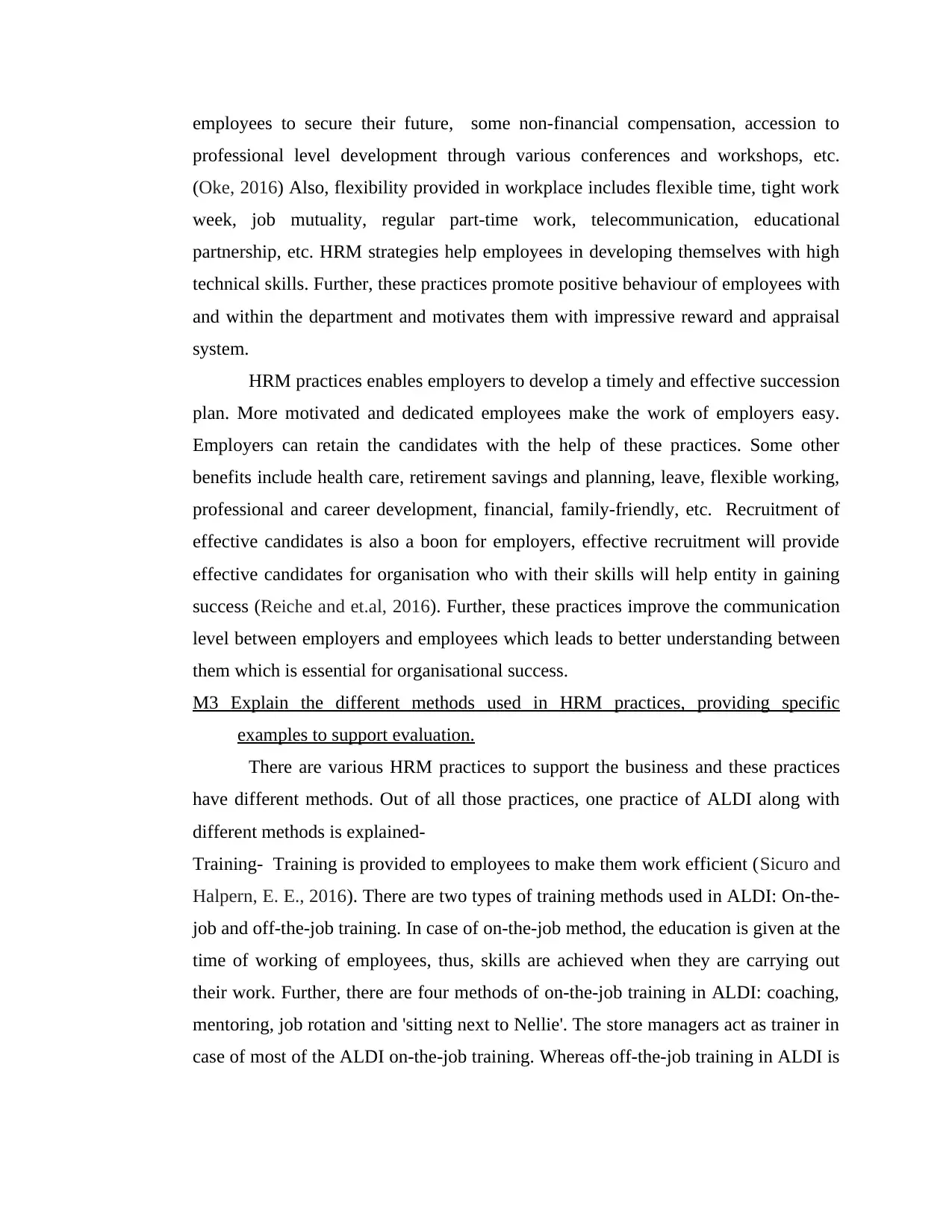
employees to secure their future, some non-financial compensation, accession to
professional level development through various conferences and workshops, etc.
(Oke, 2016) Also, flexibility provided in workplace includes flexible time, tight work
week, job mutuality, regular part-time work, telecommunication, educational
partnership, etc. HRM strategies help employees in developing themselves with high
technical skills. Further, these practices promote positive behaviour of employees with
and within the department and motivates them with impressive reward and appraisal
system.
HRM practices enables employers to develop a timely and effective succession
plan. More motivated and dedicated employees make the work of employers easy.
Employers can retain the candidates with the help of these practices. Some other
benefits include health care, retirement savings and planning, leave, flexible working,
professional and career development, financial, family-friendly, etc. Recruitment of
effective candidates is also a boon for employers, effective recruitment will provide
effective candidates for organisation who with their skills will help entity in gaining
success (Reiche and et.al, 2016). Further, these practices improve the communication
level between employers and employees which leads to better understanding between
them which is essential for organisational success.
M3 Explain the different methods used in HRM practices, providing specific
examples to support evaluation.
There are various HRM practices to support the business and these practices
have different methods. Out of all those practices, one practice of ALDI along with
different methods is explained-
Training- Training is provided to employees to make them work efficient (Sicuro and
Halpern, E. E., 2016). There are two types of training methods used in ALDI: On-the-
job and off-the-job training. In case of on-the-job method, the education is given at the
time of working of employees, thus, skills are achieved when they are carrying out
their work. Further, there are four methods of on-the-job training in ALDI: coaching,
mentoring, job rotation and 'sitting next to Nellie'. The store managers act as trainer in
case of most of the ALDI on-the-job training. Whereas off-the-job training in ALDI is
professional level development through various conferences and workshops, etc.
(Oke, 2016) Also, flexibility provided in workplace includes flexible time, tight work
week, job mutuality, regular part-time work, telecommunication, educational
partnership, etc. HRM strategies help employees in developing themselves with high
technical skills. Further, these practices promote positive behaviour of employees with
and within the department and motivates them with impressive reward and appraisal
system.
HRM practices enables employers to develop a timely and effective succession
plan. More motivated and dedicated employees make the work of employers easy.
Employers can retain the candidates with the help of these practices. Some other
benefits include health care, retirement savings and planning, leave, flexible working,
professional and career development, financial, family-friendly, etc. Recruitment of
effective candidates is also a boon for employers, effective recruitment will provide
effective candidates for organisation who with their skills will help entity in gaining
success (Reiche and et.al, 2016). Further, these practices improve the communication
level between employers and employees which leads to better understanding between
them which is essential for organisational success.
M3 Explain the different methods used in HRM practices, providing specific
examples to support evaluation.
There are various HRM practices to support the business and these practices
have different methods. Out of all those practices, one practice of ALDI along with
different methods is explained-
Training- Training is provided to employees to make them work efficient (Sicuro and
Halpern, E. E., 2016). There are two types of training methods used in ALDI: On-the-
job and off-the-job training. In case of on-the-job method, the education is given at the
time of working of employees, thus, skills are achieved when they are carrying out
their work. Further, there are four methods of on-the-job training in ALDI: coaching,
mentoring, job rotation and 'sitting next to Nellie'. The store managers act as trainer in
case of most of the ALDI on-the-job training. Whereas off-the-job training in ALDI is
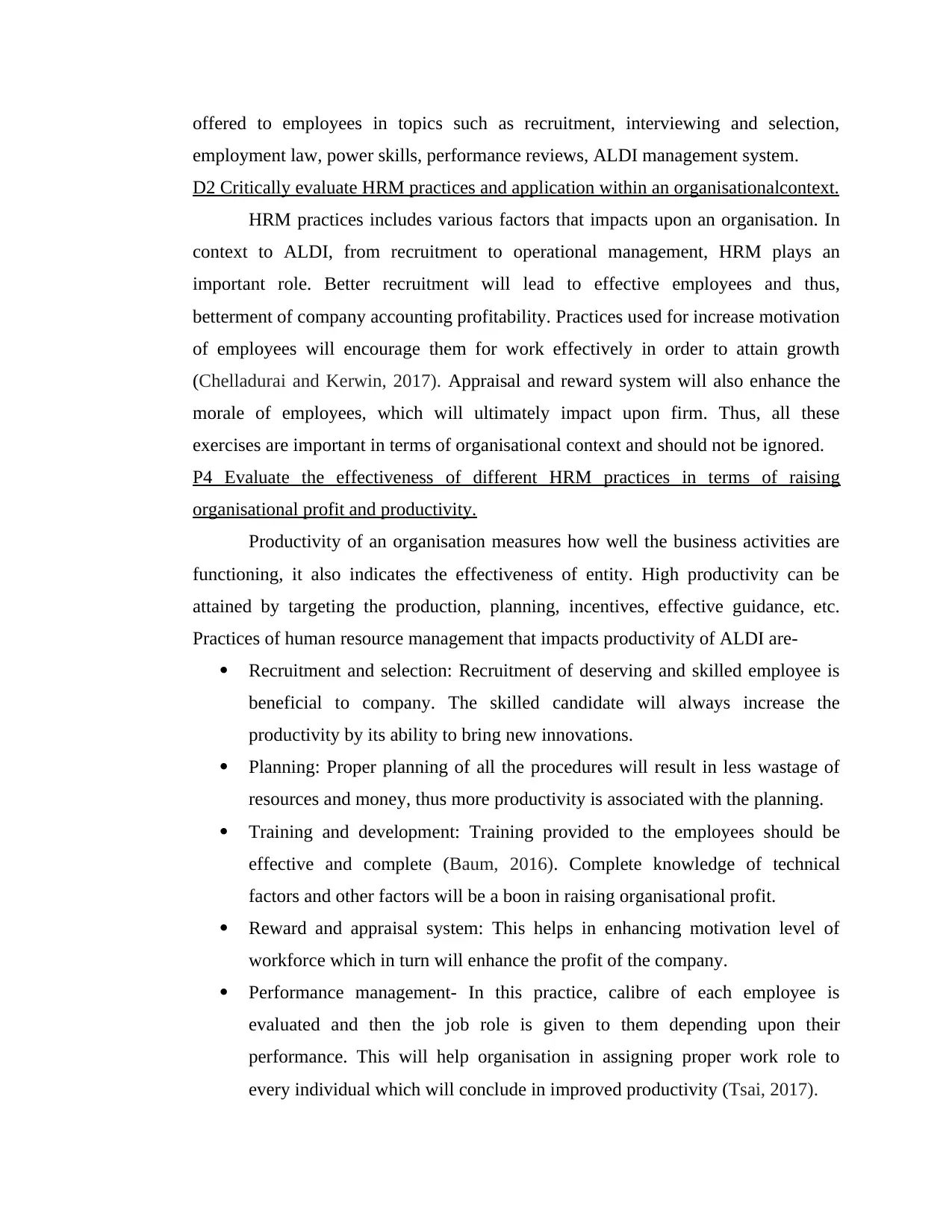
offered to employees in topics such as recruitment, interviewing and selection,
employment law, power skills, performance reviews, ALDI management system.
D2 Critically evaluate HRM practices and application within an organisationalcontext.
HRM practices includes various factors that impacts upon an organisation. In
context to ALDI, from recruitment to operational management, HRM plays an
important role. Better recruitment will lead to effective employees and thus,
betterment of company accounting profitability. Practices used for increase motivation
of employees will encourage them for work effectively in order to attain growth
(Chelladurai and Kerwin, 2017). Appraisal and reward system will also enhance the
morale of employees, which will ultimately impact upon firm. Thus, all these
exercises are important in terms of organisational context and should not be ignored.
P4 Evaluate the effectiveness of different HRM practices in terms of raising
organisational profit and productivity.
Productivity of an organisation measures how well the business activities are
functioning, it also indicates the effectiveness of entity. High productivity can be
attained by targeting the production, planning, incentives, effective guidance, etc.
Practices of human resource management that impacts productivity of ALDI are-
Recruitment and selection: Recruitment of deserving and skilled employee is
beneficial to company. The skilled candidate will always increase the
productivity by its ability to bring new innovations.
Planning: Proper planning of all the procedures will result in less wastage of
resources and money, thus more productivity is associated with the planning.
Training and development: Training provided to the employees should be
effective and complete (Baum, 2016). Complete knowledge of technical
factors and other factors will be a boon in raising organisational profit.
Reward and appraisal system: This helps in enhancing motivation level of
workforce which in turn will enhance the profit of the company.
Performance management- In this practice, calibre of each employee is
evaluated and then the job role is given to them depending upon their
performance. This will help organisation in assigning proper work role to
every individual which will conclude in improved productivity (Tsai, 2017).
employment law, power skills, performance reviews, ALDI management system.
D2 Critically evaluate HRM practices and application within an organisationalcontext.
HRM practices includes various factors that impacts upon an organisation. In
context to ALDI, from recruitment to operational management, HRM plays an
important role. Better recruitment will lead to effective employees and thus,
betterment of company accounting profitability. Practices used for increase motivation
of employees will encourage them for work effectively in order to attain growth
(Chelladurai and Kerwin, 2017). Appraisal and reward system will also enhance the
morale of employees, which will ultimately impact upon firm. Thus, all these
exercises are important in terms of organisational context and should not be ignored.
P4 Evaluate the effectiveness of different HRM practices in terms of raising
organisational profit and productivity.
Productivity of an organisation measures how well the business activities are
functioning, it also indicates the effectiveness of entity. High productivity can be
attained by targeting the production, planning, incentives, effective guidance, etc.
Practices of human resource management that impacts productivity of ALDI are-
Recruitment and selection: Recruitment of deserving and skilled employee is
beneficial to company. The skilled candidate will always increase the
productivity by its ability to bring new innovations.
Planning: Proper planning of all the procedures will result in less wastage of
resources and money, thus more productivity is associated with the planning.
Training and development: Training provided to the employees should be
effective and complete (Baum, 2016). Complete knowledge of technical
factors and other factors will be a boon in raising organisational profit.
Reward and appraisal system: This helps in enhancing motivation level of
workforce which in turn will enhance the profit of the company.
Performance management- In this practice, calibre of each employee is
evaluated and then the job role is given to them depending upon their
performance. This will help organisation in assigning proper work role to
every individual which will conclude in improved productivity (Tsai, 2017).
⊘ This is a preview!⊘
Do you want full access?
Subscribe today to unlock all pages.

Trusted by 1+ million students worldwide
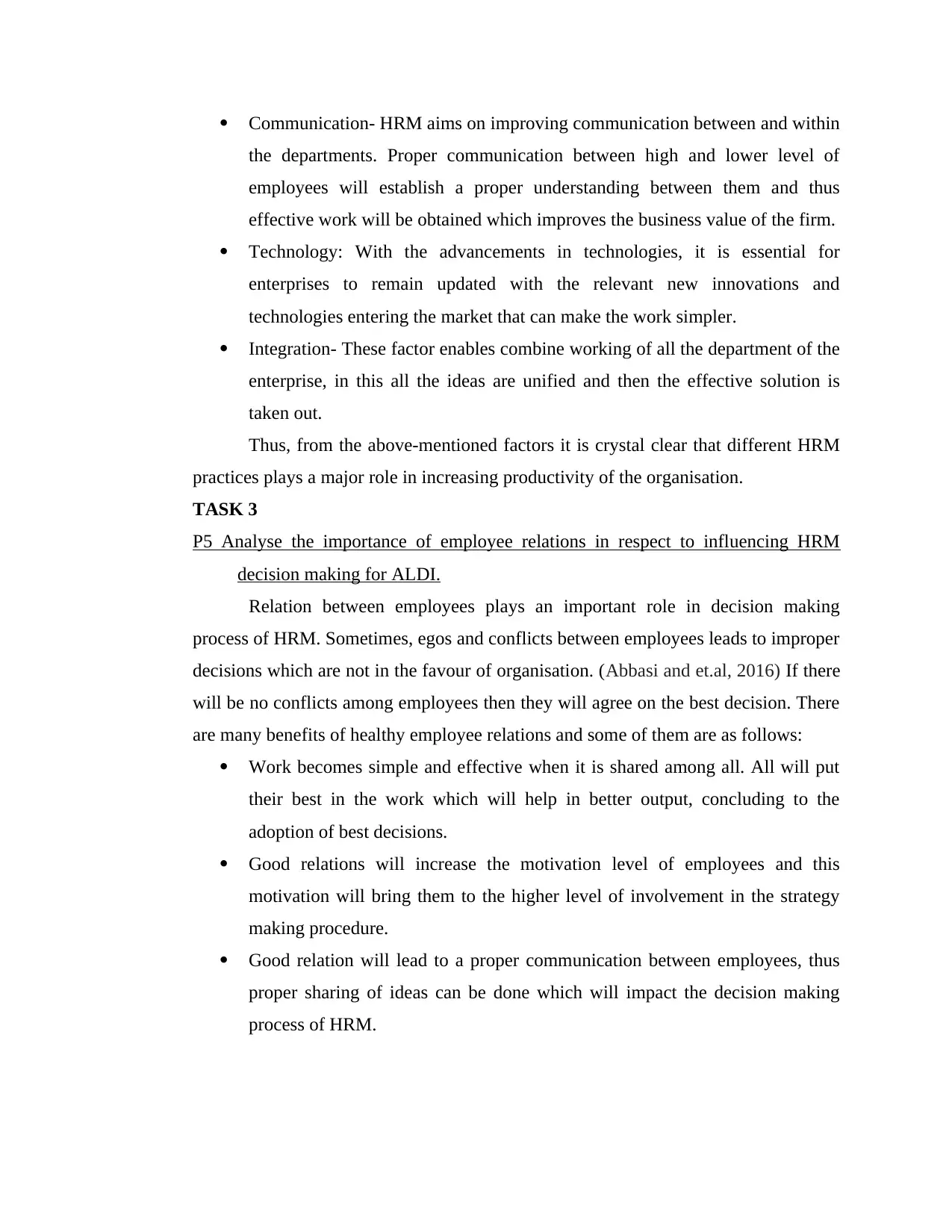
Communication- HRM aims on improving communication between and within
the departments. Proper communication between high and lower level of
employees will establish a proper understanding between them and thus
effective work will be obtained which improves the business value of the firm.
Technology: With the advancements in technologies, it is essential for
enterprises to remain updated with the relevant new innovations and
technologies entering the market that can make the work simpler.
Integration- These factor enables combine working of all the department of the
enterprise, in this all the ideas are unified and then the effective solution is
taken out.
Thus, from the above-mentioned factors it is crystal clear that different HRM
practices plays a major role in increasing productivity of the organisation.
TASK 3
P5 Analyse the importance of employee relations in respect to influencing HRM
decision making for ALDI.
Relation between employees plays an important role in decision making
process of HRM. Sometimes, egos and conflicts between employees leads to improper
decisions which are not in the favour of organisation. (Abbasi and et.al, 2016) If there
will be no conflicts among employees then they will agree on the best decision. There
are many benefits of healthy employee relations and some of them are as follows:
Work becomes simple and effective when it is shared among all. All will put
their best in the work which will help in better output, concluding to the
adoption of best decisions.
Good relations will increase the motivation level of employees and this
motivation will bring them to the higher level of involvement in the strategy
making procedure.
Good relation will lead to a proper communication between employees, thus
proper sharing of ideas can be done which will impact the decision making
process of HRM.
the departments. Proper communication between high and lower level of
employees will establish a proper understanding between them and thus
effective work will be obtained which improves the business value of the firm.
Technology: With the advancements in technologies, it is essential for
enterprises to remain updated with the relevant new innovations and
technologies entering the market that can make the work simpler.
Integration- These factor enables combine working of all the department of the
enterprise, in this all the ideas are unified and then the effective solution is
taken out.
Thus, from the above-mentioned factors it is crystal clear that different HRM
practices plays a major role in increasing productivity of the organisation.
TASK 3
P5 Analyse the importance of employee relations in respect to influencing HRM
decision making for ALDI.
Relation between employees plays an important role in decision making
process of HRM. Sometimes, egos and conflicts between employees leads to improper
decisions which are not in the favour of organisation. (Abbasi and et.al, 2016) If there
will be no conflicts among employees then they will agree on the best decision. There
are many benefits of healthy employee relations and some of them are as follows:
Work becomes simple and effective when it is shared among all. All will put
their best in the work which will help in better output, concluding to the
adoption of best decisions.
Good relations will increase the motivation level of employees and this
motivation will bring them to the higher level of involvement in the strategy
making procedure.
Good relation will lead to a proper communication between employees, thus
proper sharing of ideas can be done which will impact the decision making
process of HRM.
Paraphrase This Document
Need a fresh take? Get an instant paraphrase of this document with our AI Paraphraser
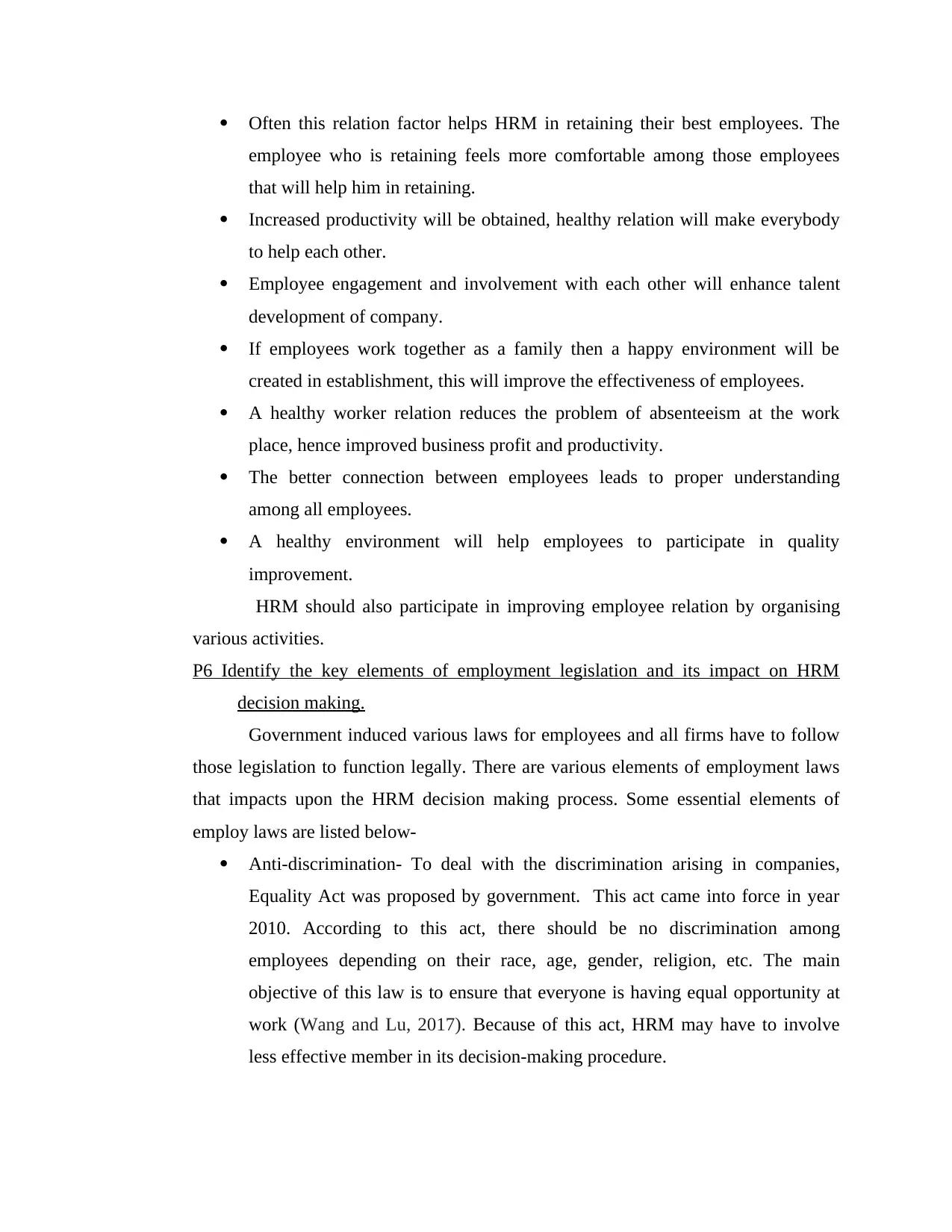
Often this relation factor helps HRM in retaining their best employees. The
employee who is retaining feels more comfortable among those employees
that will help him in retaining.
Increased productivity will be obtained, healthy relation will make everybody
to help each other.
Employee engagement and involvement with each other will enhance talent
development of company.
If employees work together as a family then a happy environment will be
created in establishment, this will improve the effectiveness of employees.
A healthy worker relation reduces the problem of absenteeism at the work
place, hence improved business profit and productivity.
The better connection between employees leads to proper understanding
among all employees.
A healthy environment will help employees to participate in quality
improvement.
HRM should also participate in improving employee relation by organising
various activities.
P6 Identify the key elements of employment legislation and its impact on HRM
decision making.
Government induced various laws for employees and all firms have to follow
those legislation to function legally. There are various elements of employment laws
that impacts upon the HRM decision making process. Some essential elements of
employ laws are listed below-
Anti-discrimination- To deal with the discrimination arising in companies,
Equality Act was proposed by government. This act came into force in year
2010. According to this act, there should be no discrimination among
employees depending on their race, age, gender, religion, etc. The main
objective of this law is to ensure that everyone is having equal opportunity at
work (Wang and Lu, 2017). Because of this act, HRM may have to involve
less effective member in its decision-making procedure.
employee who is retaining feels more comfortable among those employees
that will help him in retaining.
Increased productivity will be obtained, healthy relation will make everybody
to help each other.
Employee engagement and involvement with each other will enhance talent
development of company.
If employees work together as a family then a happy environment will be
created in establishment, this will improve the effectiveness of employees.
A healthy worker relation reduces the problem of absenteeism at the work
place, hence improved business profit and productivity.
The better connection between employees leads to proper understanding
among all employees.
A healthy environment will help employees to participate in quality
improvement.
HRM should also participate in improving employee relation by organising
various activities.
P6 Identify the key elements of employment legislation and its impact on HRM
decision making.
Government induced various laws for employees and all firms have to follow
those legislation to function legally. There are various elements of employment laws
that impacts upon the HRM decision making process. Some essential elements of
employ laws are listed below-
Anti-discrimination- To deal with the discrimination arising in companies,
Equality Act was proposed by government. This act came into force in year
2010. According to this act, there should be no discrimination among
employees depending on their race, age, gender, religion, etc. The main
objective of this law is to ensure that everyone is having equal opportunity at
work (Wang and Lu, 2017). Because of this act, HRM may have to involve
less effective member in its decision-making procedure.
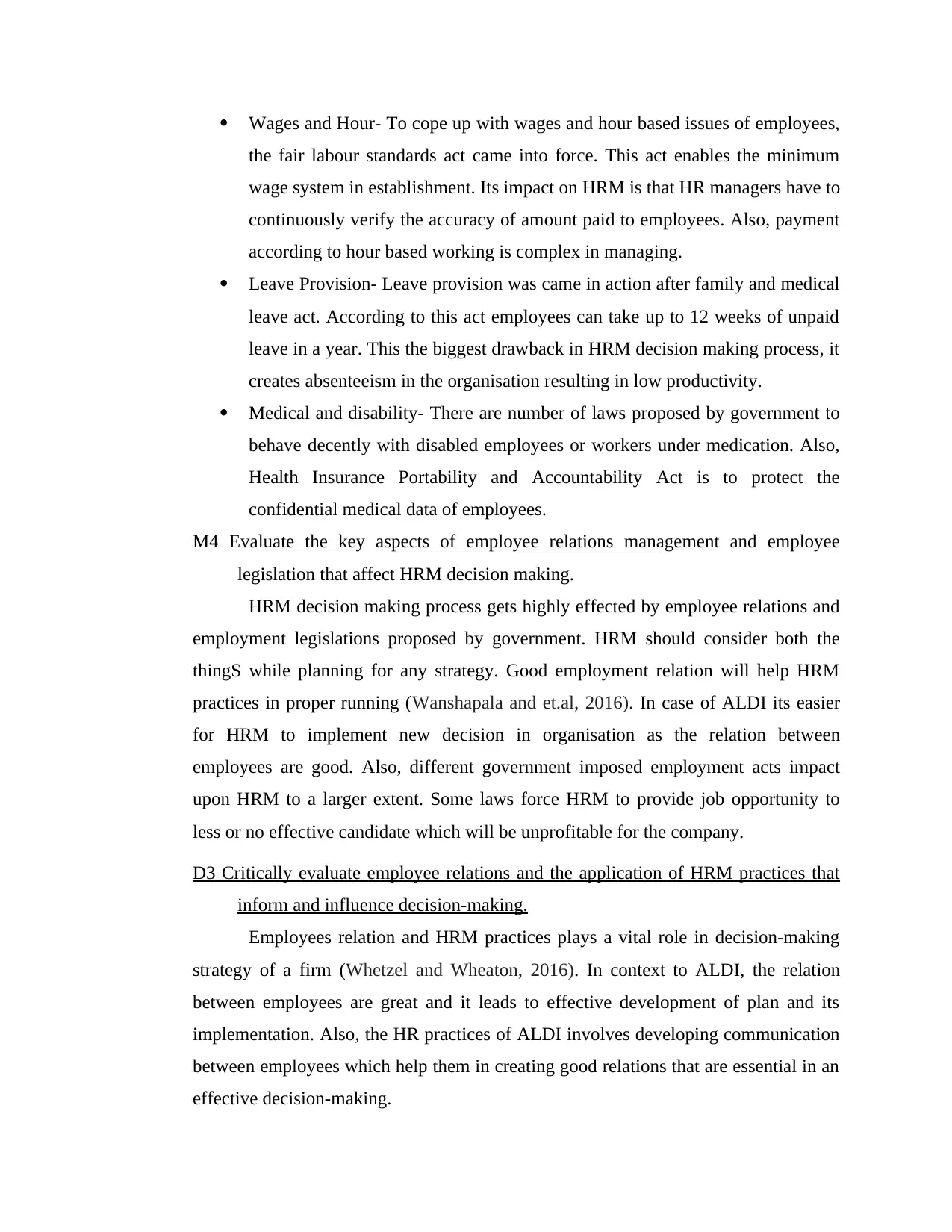
Wages and Hour- To cope up with wages and hour based issues of employees,
the fair labour standards act came into force. This act enables the minimum
wage system in establishment. Its impact on HRM is that HR managers have to
continuously verify the accuracy of amount paid to employees. Also, payment
according to hour based working is complex in managing.
Leave Provision- Leave provision was came in action after family and medical
leave act. According to this act employees can take up to 12 weeks of unpaid
leave in a year. This the biggest drawback in HRM decision making process, it
creates absenteeism in the organisation resulting in low productivity.
Medical and disability- There are number of laws proposed by government to
behave decently with disabled employees or workers under medication. Also,
Health Insurance Portability and Accountability Act is to protect the
confidential medical data of employees.
M4 Evaluate the key aspects of employee relations management and employee
legislation that affect HRM decision making.
HRM decision making process gets highly effected by employee relations and
employment legislations proposed by government. HRM should consider both the
thingS while planning for any strategy. Good employment relation will help HRM
practices in proper running (Wanshapala and et.al, 2016). In case of ALDI its easier
for HRM to implement new decision in organisation as the relation between
employees are good. Also, different government imposed employment acts impact
upon HRM to a larger extent. Some laws force HRM to provide job opportunity to
less or no effective candidate which will be unprofitable for the company.
D3 Critically evaluate employee relations and the application of HRM practices that
inform and influence decision-making.
Employees relation and HRM practices plays a vital role in decision-making
strategy of a firm (Whetzel and Wheaton, 2016). In context to ALDI, the relation
between employees are great and it leads to effective development of plan and its
implementation. Also, the HR practices of ALDI involves developing communication
between employees which help them in creating good relations that are essential in an
effective decision-making.
the fair labour standards act came into force. This act enables the minimum
wage system in establishment. Its impact on HRM is that HR managers have to
continuously verify the accuracy of amount paid to employees. Also, payment
according to hour based working is complex in managing.
Leave Provision- Leave provision was came in action after family and medical
leave act. According to this act employees can take up to 12 weeks of unpaid
leave in a year. This the biggest drawback in HRM decision making process, it
creates absenteeism in the organisation resulting in low productivity.
Medical and disability- There are number of laws proposed by government to
behave decently with disabled employees or workers under medication. Also,
Health Insurance Portability and Accountability Act is to protect the
confidential medical data of employees.
M4 Evaluate the key aspects of employee relations management and employee
legislation that affect HRM decision making.
HRM decision making process gets highly effected by employee relations and
employment legislations proposed by government. HRM should consider both the
thingS while planning for any strategy. Good employment relation will help HRM
practices in proper running (Wanshapala and et.al, 2016). In case of ALDI its easier
for HRM to implement new decision in organisation as the relation between
employees are good. Also, different government imposed employment acts impact
upon HRM to a larger extent. Some laws force HRM to provide job opportunity to
less or no effective candidate which will be unprofitable for the company.
D3 Critically evaluate employee relations and the application of HRM practices that
inform and influence decision-making.
Employees relation and HRM practices plays a vital role in decision-making
strategy of a firm (Whetzel and Wheaton, 2016). In context to ALDI, the relation
between employees are great and it leads to effective development of plan and its
implementation. Also, the HR practices of ALDI involves developing communication
between employees which help them in creating good relations that are essential in an
effective decision-making.
⊘ This is a preview!⊘
Do you want full access?
Subscribe today to unlock all pages.

Trusted by 1+ million students worldwide
1 out of 15
Related Documents
Your All-in-One AI-Powered Toolkit for Academic Success.
+13062052269
info@desklib.com
Available 24*7 on WhatsApp / Email
![[object Object]](/_next/static/media/star-bottom.7253800d.svg)
Unlock your academic potential
Copyright © 2020–2025 A2Z Services. All Rights Reserved. Developed and managed by ZUCOL.




